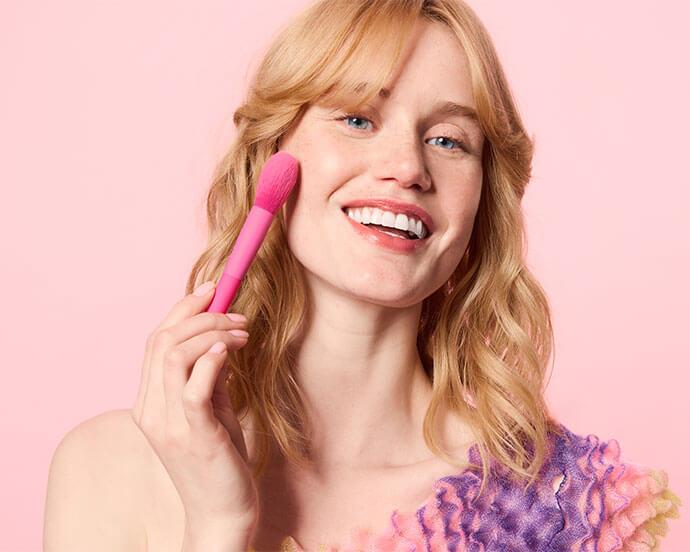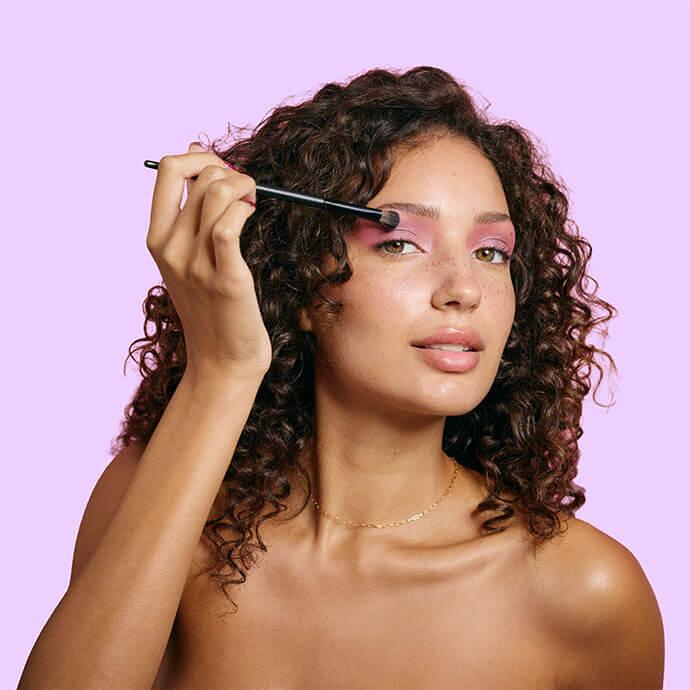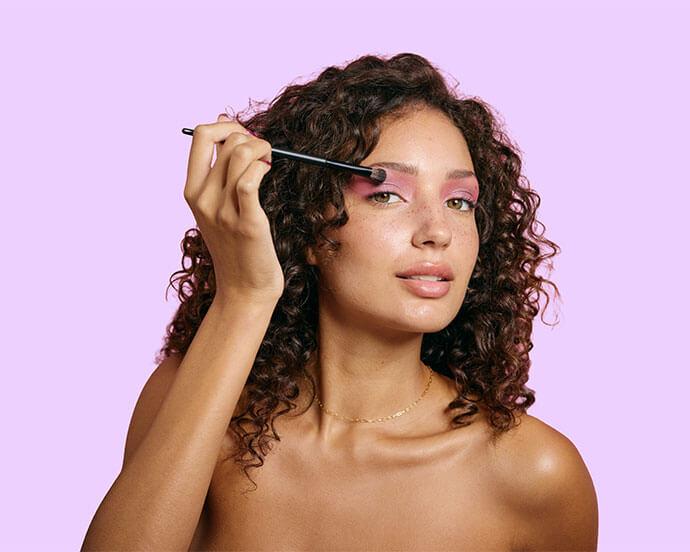How to Contour Your Face: Your Step-By-Step Guide to Contouring



Maddie Aberman


Contouring has been a go-to technique among makeup artists for decades now—and for good reason. From defining your cheekbones to sculpting your jawline to emphasizing your unique face shape, contouring can boost any makeup look by adding depth and dimension to your facial features and bone structure. While it might feel like an intimidating makeup step to master (we’re looking at you too, winged eyeliner), this beauty technique isn’t nearly as complicated as it may seem—trust us.
Read on to discover which contour shades are best to use for your skin tone, a step-by-step tutorial on how to contour, plus a few tips on how to customize your contour to better suit your face shape.


It's about glam time you treated yourself.
MEET THE EXPERT
Melissa Hurkman is a celebrity makeup artist based in Los Angeles. She has worked with Jessie James Decker, JoJo Fletcher, and Hannah Ann.
Alex Levy is a New York–based makeup artist and beauty marketing consultant.
Ash K Holm is IPSY’s Chief Makeup Artist. She has perfected a signature soft glam look on some of Hollywood’s most famous faces (just peep her Instagram for a look at her A-list client roster), and now the in-demand makeup artist is at your service.
What Exactly Is Contouring?
“Contouring is a technique to sculpt the face with makeup,” Hurkman says. “This is also a great technique to softly ‘correct’ any features or slim areas of the face. You can even contour to enhance any areas to make them appear larger.”
Basically, contouring is the opposite of highlighting. While highlighting "highlights" facial features by adding light to certain areas of your face, contouring involves darkening areas you want to define or recede. "Contouring is adding dimension and definition to the face using makeup to mimic light and shadow,” says Levy.
For example, one of the most common areas to contour is the hollows of your cheeks. Adding a darker color to this area sculpts your cheekbones by creating a shadow, making them appear sharper, higher, and more defined. You can also contour the shape of your eyes, your nose, brow bones, cupid’s bow, or jawline. One thing remains true, though, no matter what area of the face you decide to contour: “Contouring adds instant life,” says Holm.
What Is Makeup Sculpting?
Let’s be real: Contouring walked so sculpting could strut. At its core, makeup sculpting is all about enhancing your natural bone structure—cheekbones, jawline, nose, you name it—using a mix of contour, highlight, and sometimes blush (shoutout to the overachievers). It’s not just about creating shadows—it’s about creating shape, balance, and that she looks expensive energy.
Where contouring typically focuses on adding dimension in a few key spots, sculpting zooms out to take the whole face into account. Think of it as contour’s cooler, more evolved cousin who knows lighting, angles, and how to make you look lifted and snatched without a single filter.
Been loving “soft sculpt” or “snatural glam” looks lately? You’re already in sculpting territory. The best part? Sculpting doesn’t mean covering up or changing your face—it’s about playing up what makes it yours. Because the goal isn’t perfection—it’s presence.
Choosing the Right Contour Shade
Finding the perfect contour shade? It’s part science, part magic. But don’t worry—we’ve cracked the code. The key to a natural-looking sculpt is choosing a shade that’s just a couple tones deeper than your skin and in the right undertone to mimic real shadows (read: not too orange, not too ashy).
Below, we break it down by skin tone and undertone so you can contour with confidence—and avoid the dreaded muddy streaks.
Fair Skin Tones
Cool Undertones: Soft taupe, greyish browns, and neutral browns. Avoid: Orange-based or overly warm shades (they’ll look unnatural)
Warm Undertones: Neutral browns, soft sandy browns (avoid anything too ashy). Avoid: Grey-based or overly cool tones
Neutral Undertones: Neutral taupe, soft browns. Avoid: Anything too warm or too cool—stay balanced
Light Skin Tones
Cool Undertones: Cool-toned browns, taupes. Avoid: Warm or orange-based shades
Warm Undertones: Light golden browns, soft neutrals. Avoid: Ashy or grey-based shades
Neutral Undertones: Balanced browns, neutral taupes. Avoid: Anything extreme on either end of the undertone spectrum
Medium Skin Tones
Cool Undertones: Neutral browns, cooler taupes. Avoid: Orange-based or very warm tones
Warm Undertones: Warm caramel, golden browns, light mocha. Avoid: Ashy or overly grey shades
Neutral Undertones: Balanced browns, neutral taupes. Avoid: Anything too warm or cool—it’s all about harmony
Olive Undertones: Olive hues, golden browns. Avoid: Pink-based or overly ashy/cool tones
Tan Skin Tones
Cool Undertones: Deeper neutral browns. Avoid: Orange-based shades, overly warm tones
Warm Undertones: Deep golden browns, soft cocoa, saddle browns. Avoid: Grey-based or overly cool shades
Neutral Undertones: Rich neutral browns. Avoid: Anything extreme—stick to the middle
Olive Undertones: Golden browns, saddle browns. Avoid: Pink or ashy shades
Deep Skin Tones
Cool Undertones: Deep neutral browns, espresso. Avoid: Overly red-based or warm shades (unless balancing undertone)
Warm Undertones: Rich espresso, deep chocolate. Avoid: Grey-based or ashy tones
Neutral Undertones: Deep cocoa, neutral browns with red/blue balance. Avoid: Anything extremely warm or cool
TL;DR: Your Contour Checklist
Go 1–2 shades deeper than your foundation
Match your undertone (cool, warm, neutral, or olive)
Avoid shades that look orange, grey, or overly pink
Blend, blend, and blend again
How to Contour in 5 Easy Steps
Now that you've decided which type of contouring product is best for you, this is how to apply it to different parts of your face.


This infographic will visually break down the five essential steps for a flawless contour application, making it easy for readers to follow.
Step 1: Apply Primer and Foundation

First, you will want to begin your makeup routine just like you normally would—with moisturizer, primer, and a powder foundation or liquid foundation (depending on preference and skin type). “Adding definition to the face after doing complexion typically works best for me, but everyone works differently. [It’s fine] as long as you're blending along the way and avoiding harsh lines,” says Levy. Apply your foundation using a beauty blender or fluffy brush like the F.A.R.A.H Flat Foundation Brush. If using a powder foundation, you may want to apply a finishing powder or setting powder as well.
Step 2: Contour Your Forehead

“Whenever I’m contouring, I always start with my forehead because this makes a really great guide for the face,” Holm explains. Using a cream contour is easiest because the formulation is easy to blend and leaves little room for error. Holm suggests placing small lines along the hairline, blending the product smoothly from your temple to about one-third of the way to the center of your forehead. Remember: Less product is always better. Start off with a small amount and build your way up to your desired pigmentation.
Step 3: Contour Your Cheekbones and Jaw

After the contour around the hairline is well-blended, move down to the hollows of your cheeks. (If you don’t know where this is, suck in your cheekbones. See where the indentation forms just below the apples of your cheeks? That’s it.) Another pro-level trick to finding where to place your cheekbone contour is by “holding the [contour] stick at the top of the ear and bringing it downward,” suggests Holm. Placing contour here will give the illusion of sculpted cheekbones and will help give a lifted effect to the face (think: Bella Hadid).
Once the contour along your cheekbones is blended, Holm suggests placing your contour along the “natural shadow right underneath the jawline.” Taking your contour to your jawline will not only add structure to the face, but will also help pull the whole contour look together.
Step 4: Contour Your Nose (If You Want)

Adding a bit of contouring to the sides of the nose is a great extra step to add if you want to boost your contouring routine. “I like to take my brush and apply two lines on the sides of the nose,” says Holm. She also suggests applying and blending the contour with a tiny brush “for the most perfect placement.” To finish off your nose contour, apply highlighter along the bridge of your nose.
Step 5: Finish with Highlighter & Bronzer

As a final step, finish by applying highlighter and applying bronzer. For our top product picks, check out our lists that feature the best highlighters and the best bronzers for the ultimate sun-kissed look.
How to Contour for Your Face Shape
As you become more comfortable with using contour products, try customizing it to specifically accentuate your face shape. “Every face is different, and every look calls for adapted technique. But I always think adding a deeper, cooler shade just under the cheekbones and under near the jawline adds a lifted effect to the face, blending away harsh lines to create a more natural effect,” says Levy. He says the best way to contour for your face shape is by keeping your favorite features in mind at all times and asking yourself what you want to emphasize.


A visual guide illustrating contour placements tailored to various face shapes (oval, round, square, heart, square).
Round Face Shape
“Round face shapes (myself included) tend to lose the shape of our cheekbones, so contouring under our cheeks is going to give us the illusion of sunken in cheekbones,” Hurkman says. Those with a round face will want to start by applying contour at your temples.
Then, move down from there to the hollows of your cheeks, just underneath your cheekbones.
From there, move back out to the edge of your face and down again to your jawline. When putting these two steps together, they should combine to make a small three-like motion, similar to the basic shape we outlined in the tutorial above.
Square Face Shape
Begin by sucking in your cheeks just slightly to identify where the hollows of your cheeks are. Once you find that line, lightly apply contour in that area on both sides of the face. “Softening the temples and the jawline with contour is a great area for placement,” Hurkman says.
Next, move down to your jawline and dust contour from behind your ear to right along the edge of the jawline.
Finish by lightly coating contour along your hairline.
Rectangle Face Shape
Add contour to the hollows of your cheeks. For rectangle-shaped faces, try to avoid applying contour too far into the center of the face. Instead, keep it closer to the sides of your face.
Move up to your forehead and apply contour along the hairline, starting in the center and stopping before you reach your temples.
Finally, move down to your jawline and apply contour along the edges of your jaw, stopping about halfway to your chin.
Finish with a light dusting of contour right at the center of your chin.
Oval Face Shape
Those with oval-shaped faces will have the easiest time customizing their contour, as it’s really only needed in the cheek area. Simply apply contour in the hollow of your cheeks and blend until seamless.
Because your forehead and jawline are both already quite narrow, you can skip applying contour to these areas.
Heart Face Shape
“Contouring around the temples of the forehead for heart shaped faces typically works best,” Hurkman says. “This will create more of a balance to the rest of the face.” Begin by applying contour from the center of your forehead and sweeping down along your temples on both sides, following your hairline as you move down.
From there, swoop down into the hollow of your cheeks, moving in towards the apple of your cheeks, and then back out.
Contouring FAQ
Whether you're a total beginner or a contour connoisseur, these are the most-asked questions we get about sculpting your way to snatched perfection.
What is the best placement for contour?
Contour works best where shadows naturally fall—think: just below your cheekbones, along the sides of your nose, at your hairline, and under your jaw. Not sure where to start? Our step-by-step guide to contouring walks you through every area for a sculpted, lifted effect.
How can I use contour to help with an asymmetrical face?
Contouring is kind of like a face editor in real life. If you’re looking to even things out, strategic shading can help balance features and bring harmony to your look. The key? Focus on softening or emphasizing areas to guide the eye. Learn exactly how with our guide to contouring an asymmetrical face.
What’s the difference between contouring and bronzing?
Great question—and one that gets mixed up a lot. Contour is cool-toned and mimics shadows to define your bone structure. Bronzer is warm-toned and brings a sun-kissed glow to areas where the sun naturally hits (like your forehead, nose, and cheeks). TL;DR: Contour sculpts. Bronzer warms. And yes, you can absolutely use both.
Can you use concealer for contouring?
You totally can—if you pick the right shades. A concealer a few shades darker than your skin tone can double as a cream contour in a pinch. Just make sure it’s not too warm (we’re sculpting, not bronzing!). Bonus: A lighter concealer can also highlight high points of your face for a full underpainting moment. Check out our blush contouring tips for even more multi-tasking magic.
How do I choose the right contour shade for my skin tone?
The best contour shade depends on both your skin tone and undertone. Generally, go one to two shades deeper than your foundation, with a cooler or more neutral undertone to mimic natural shadows. For more precision (and less guesswork), our how to contour guide breaks it all down for every skin tone and face shape.
Liked this post? Share!
Related Stories


How-To
Blush 101: Your Go-To Guide on How to Apply Blush for Your Face Shape
Published on Dec 12, 2025 • 12 min read


How-To
How to Apply Eyeshadow: A Beginner’s Guide to Flawless Eye Looks
Published on Dec 4, 2025 • 10 min read


How-To
How to Do Winged Eyeliner Like a Pro (No Steady Hand Required)
Published on Dec 3, 2025 • 9 min read
How-To
Try a Soft Goth Aesthetic This Season to Evoke Your Inner Wednesday Addams
Published on Feb 23, 2023


How-To
Everything You’ve Ever Wanted to Know About Mastering the Art of Bronzer
Published on Nov 5, 2025 • 10 min read


How-To
Blush Sticks 101: How to Apply Them and the Best Blush Sticks to Use
Published on Nov 5, 2025 • 13 min read


How-To
How to Treat Yourself: 39 Simple Self-Care Ideas
Published on Oct 22, 2025 • 15 min read


How-To
How to Cover Melasma With Makeup Like a Pro in 4 Simple Steps
Published on Sep 26, 2025 • 5 min read


Beauty Picked Just for You
Get 5 products worth up to $70
Plus exclusive access to epic deals up to 80% off
Starting at just $14/month. Cancel anytime.